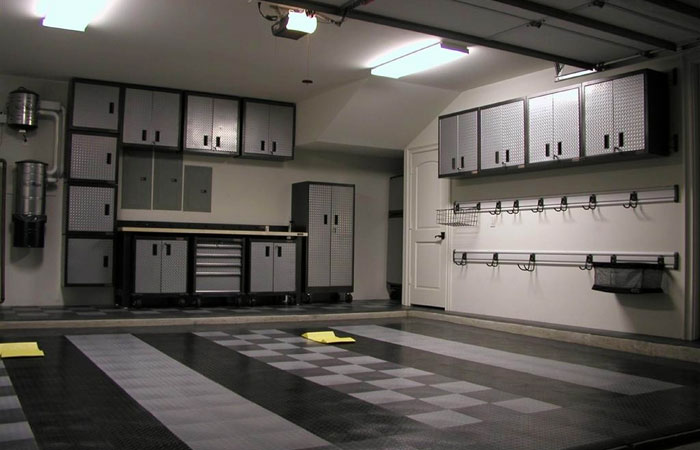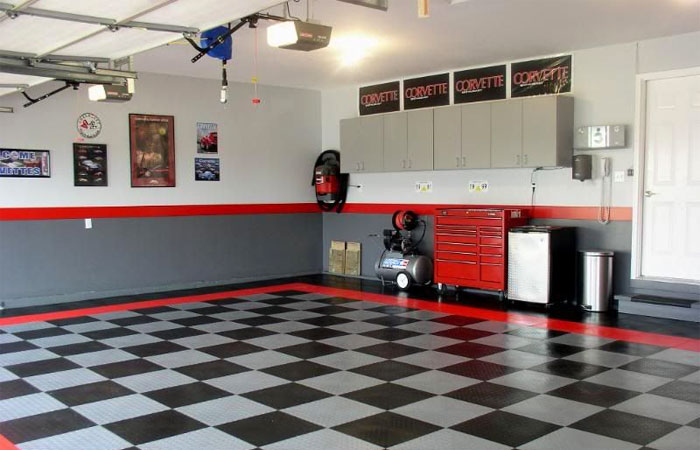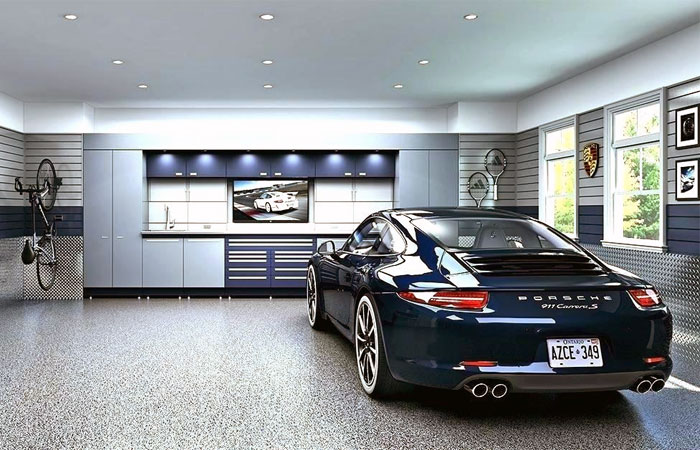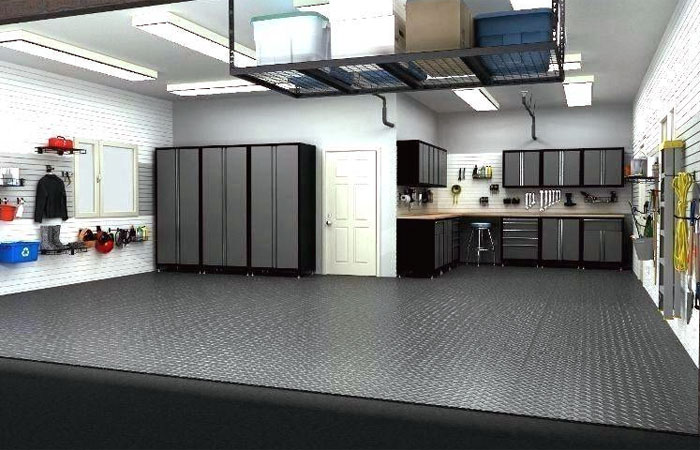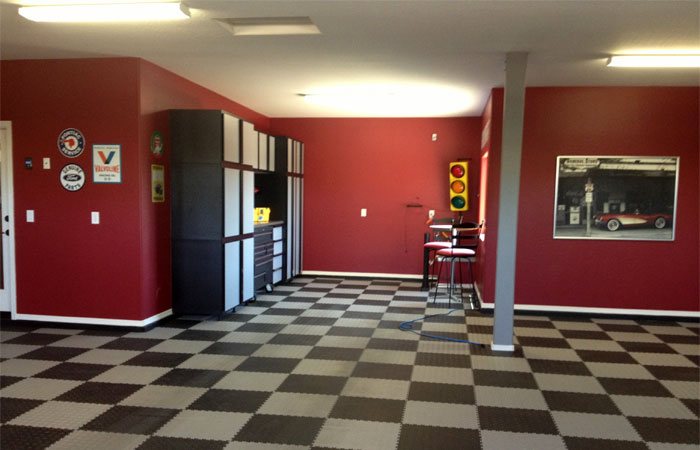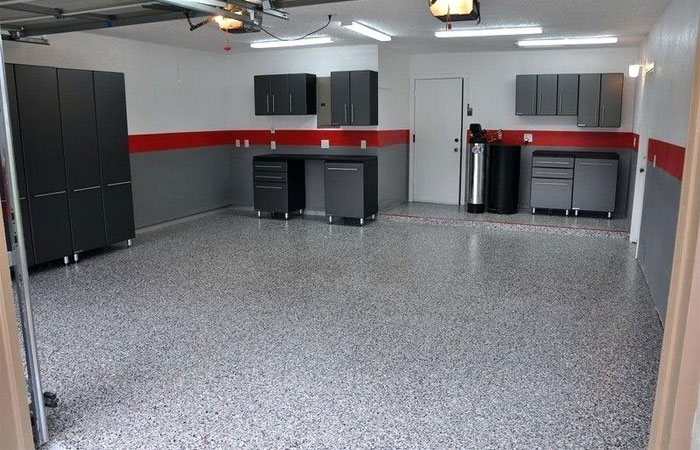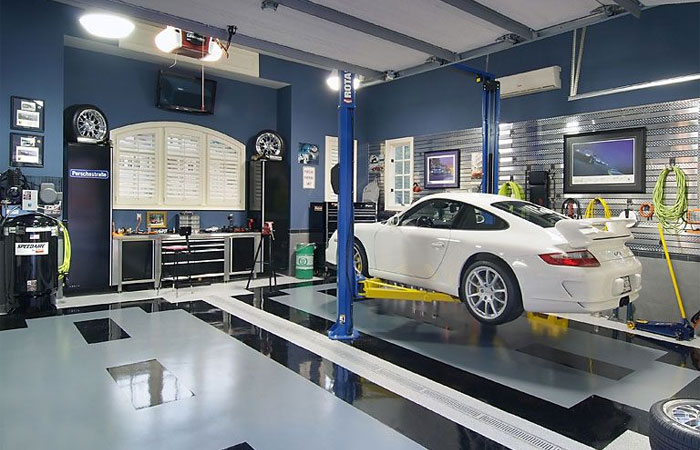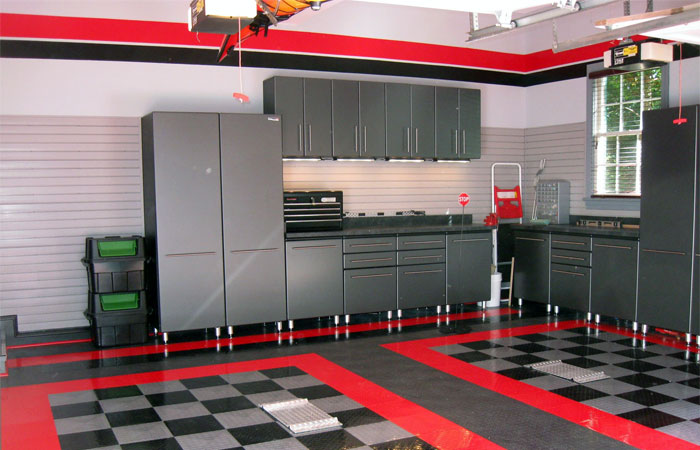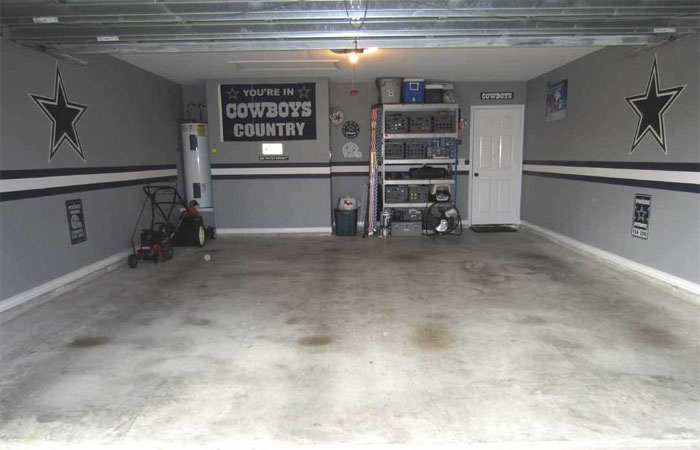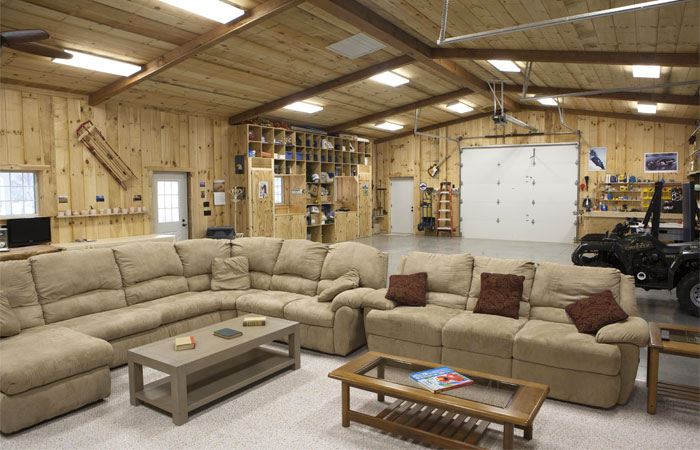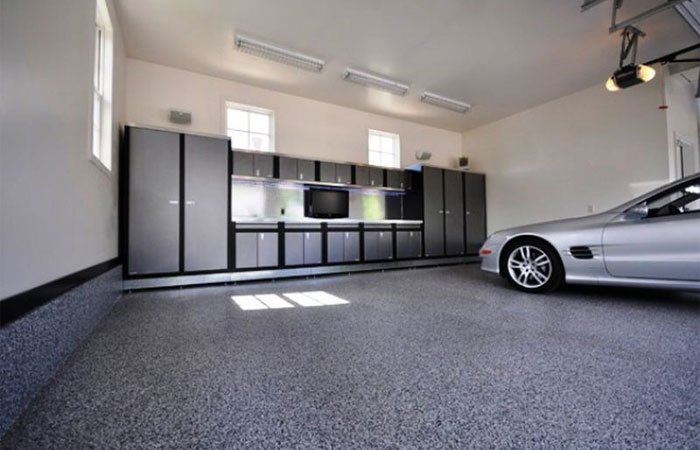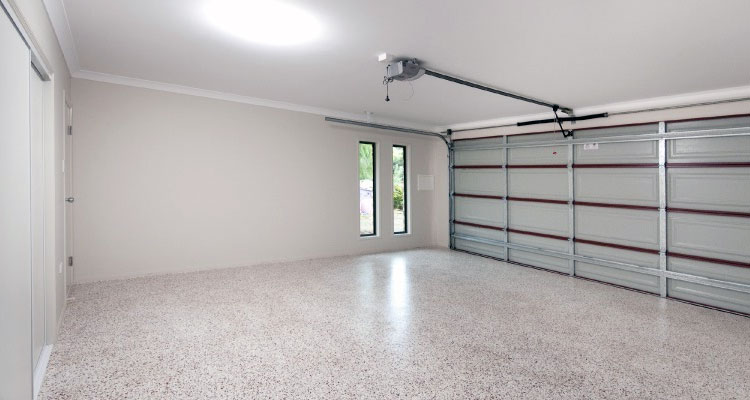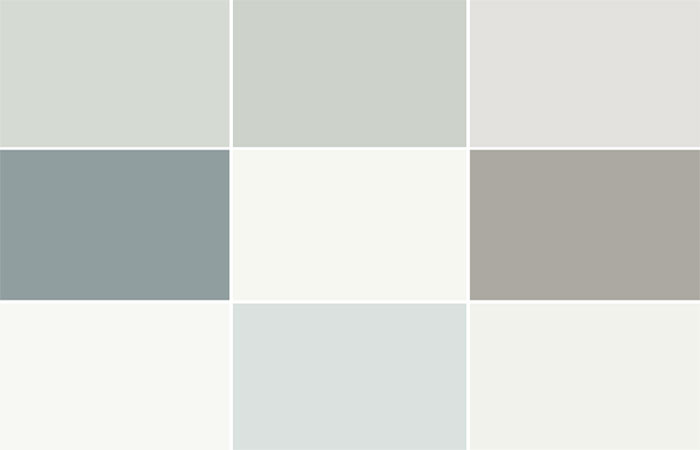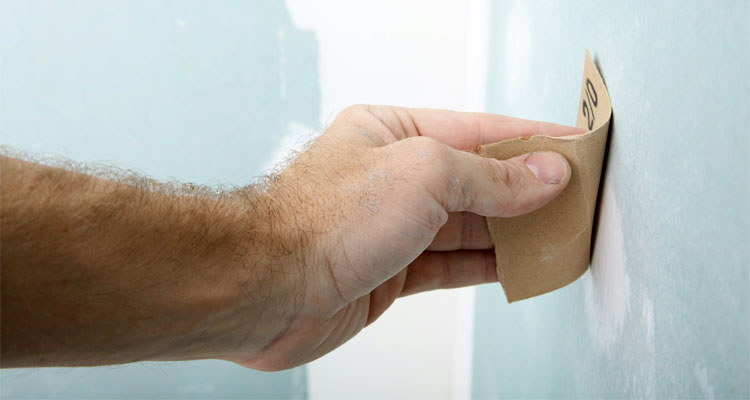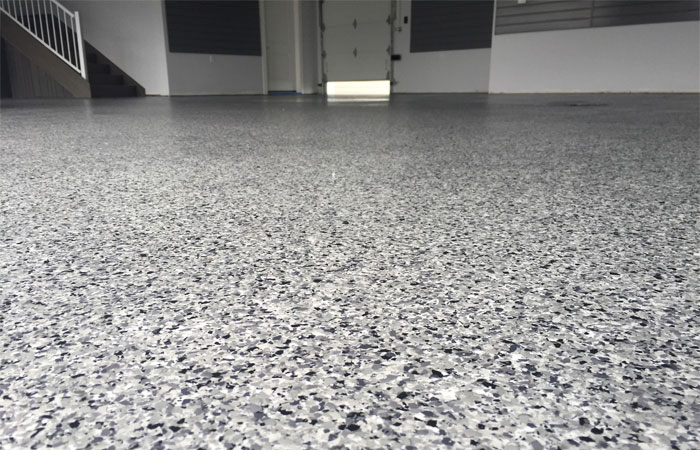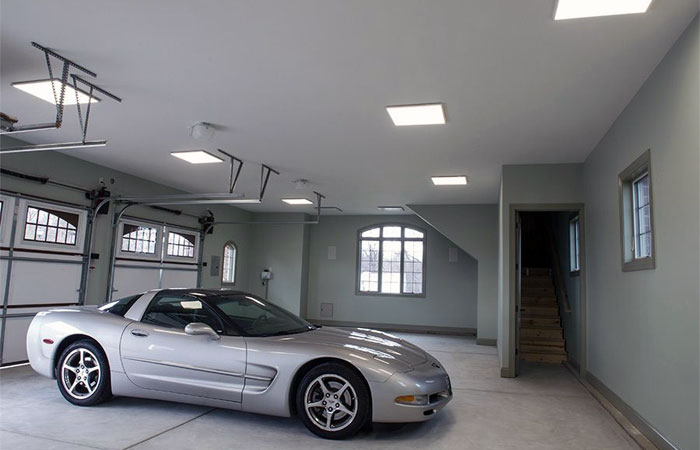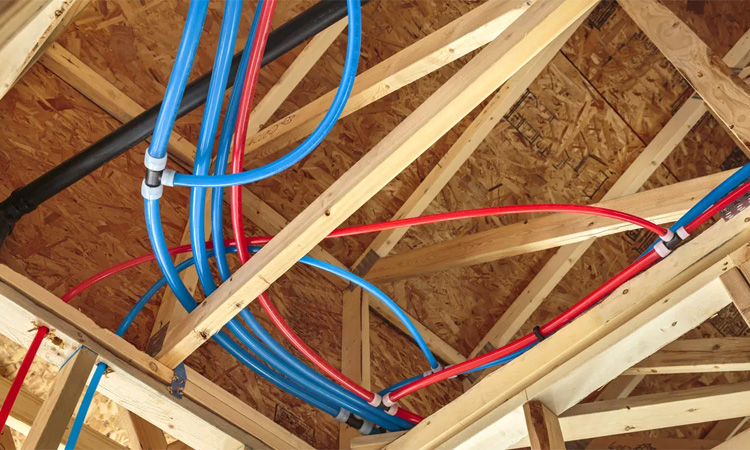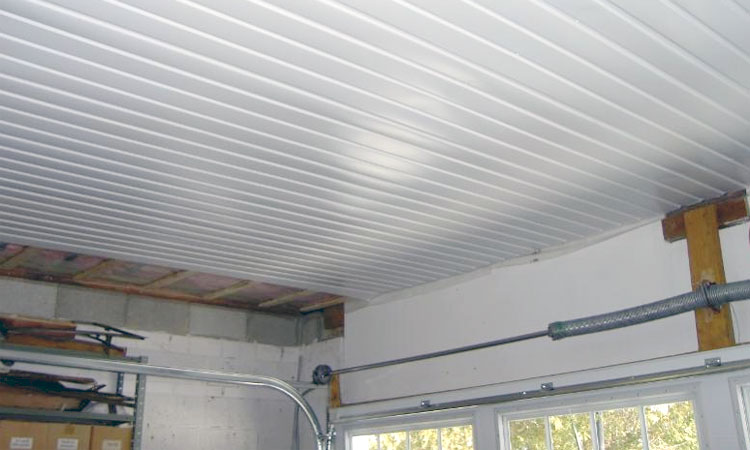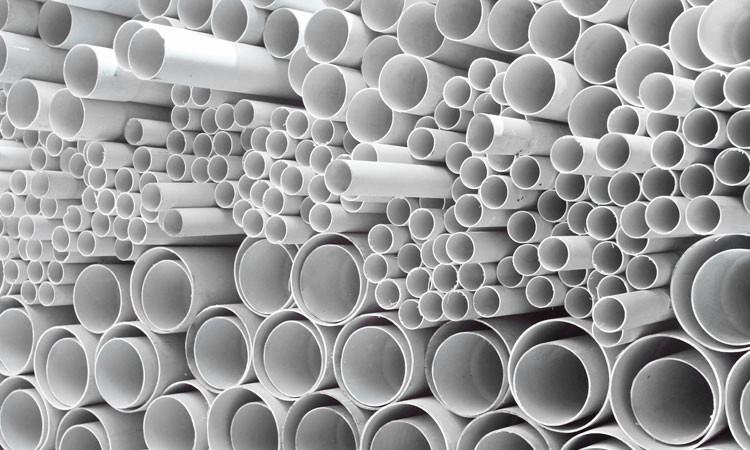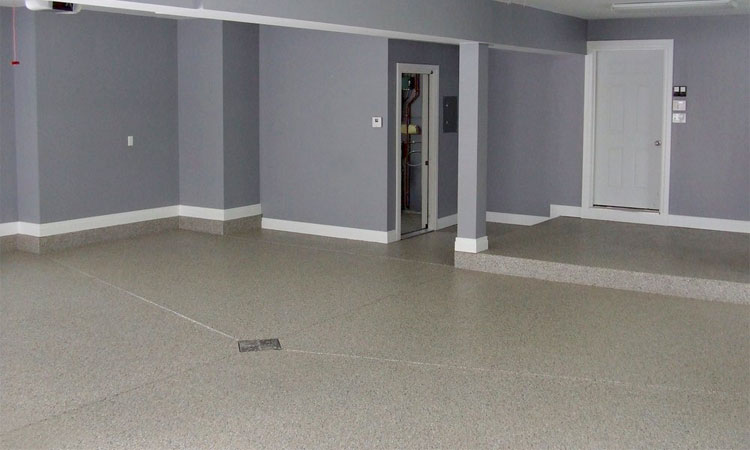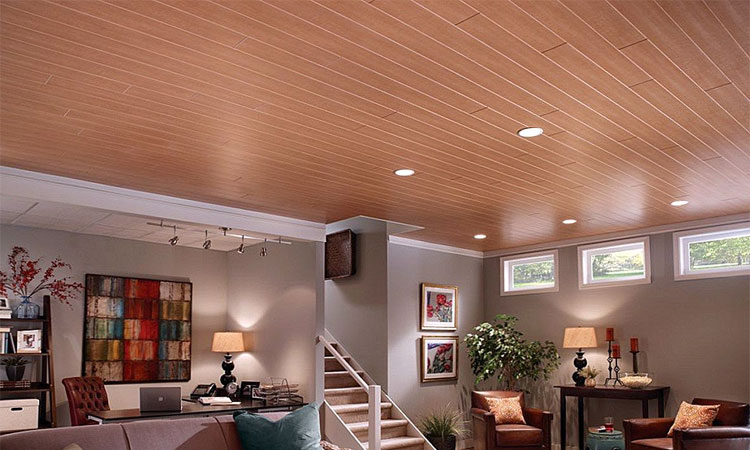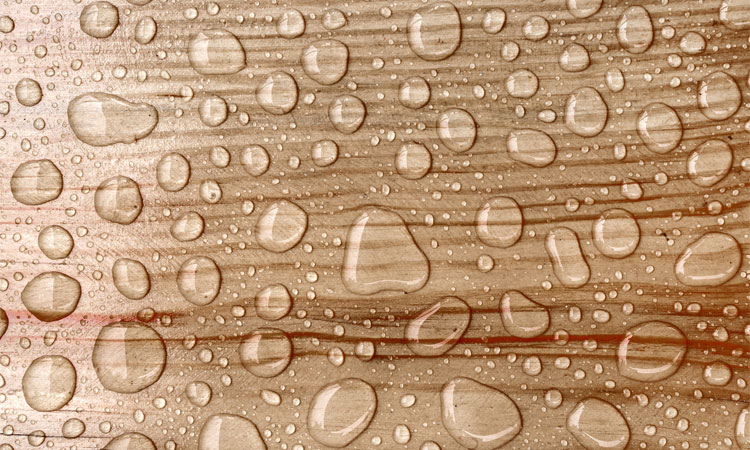27 Garage Paint Ideas and Tips (for Garage Interiors)
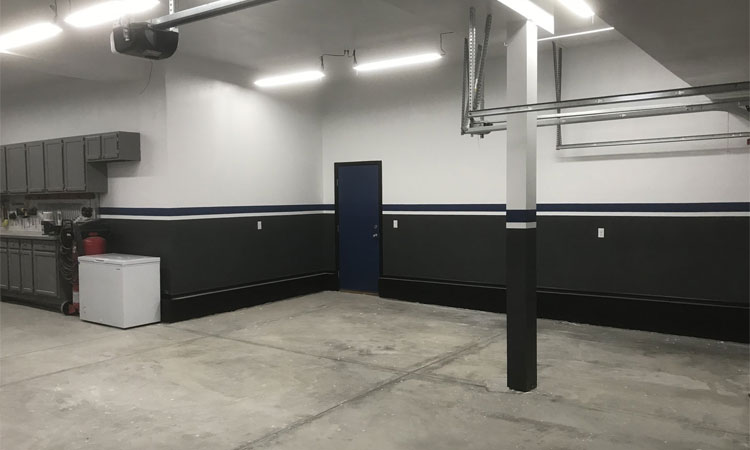
A garage is a room of endless possibilities. It can be anything from a workspace full of tools for auto repair, woodworking, yard work, DIY projects, to a home gym, man cave, or storage room.
Just because most garages have unfinished walls with drywall, tape, and mud, doesn’t mean yours should stay that way. Not only do painted walls look better, they’re easier to clean, make the inside of your garage look brighter, and allow you to add some easy customization.
Here you’ll find 27 different garage paint ideas, color schemes, and garage designs to give you a bit of inspiration no matter what size of garage you have. In addition, you’ll learn six important tips for garage painting and design to help get that look you want.
Garage Paint Ideas
Below are just a few examples of various garage paint color schemes and designs:
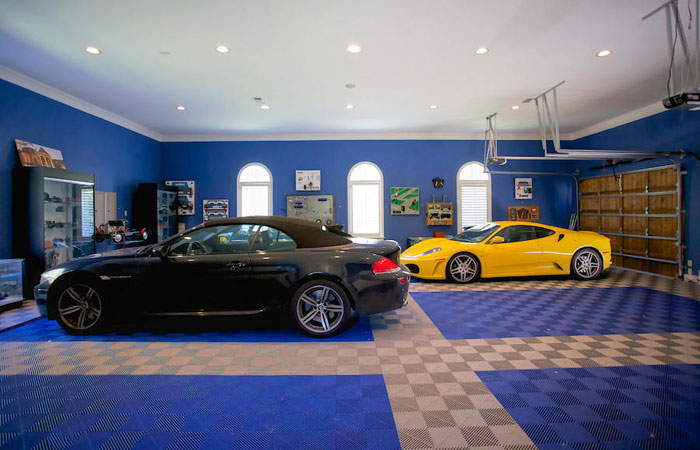
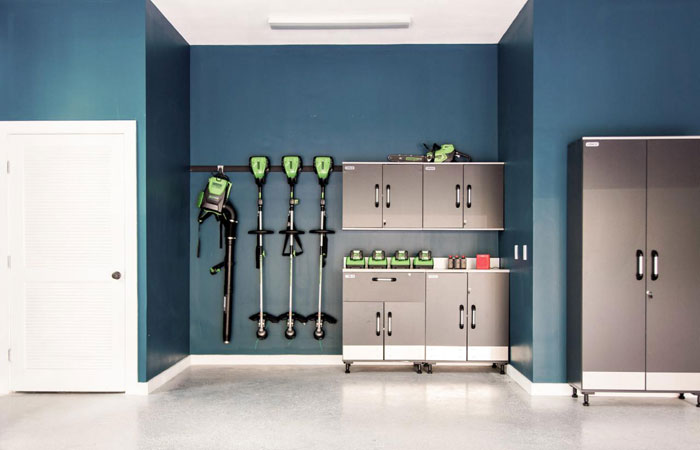
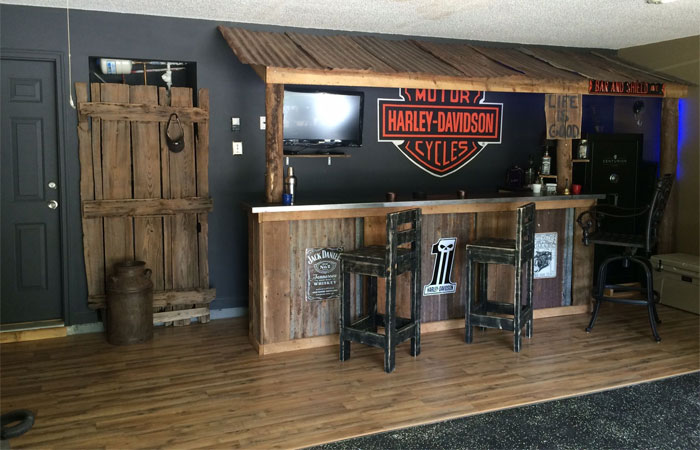
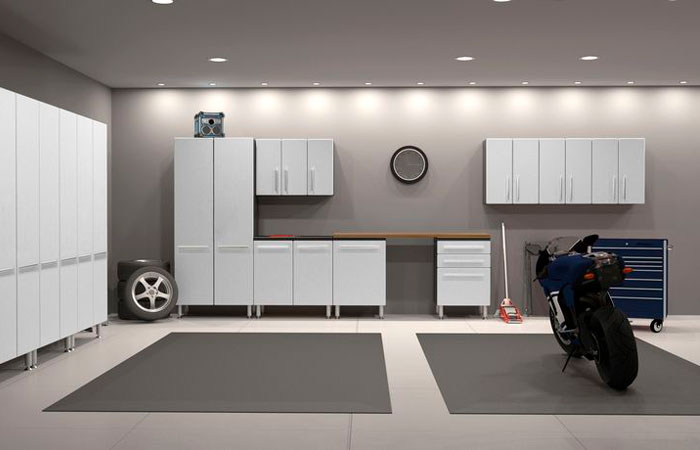
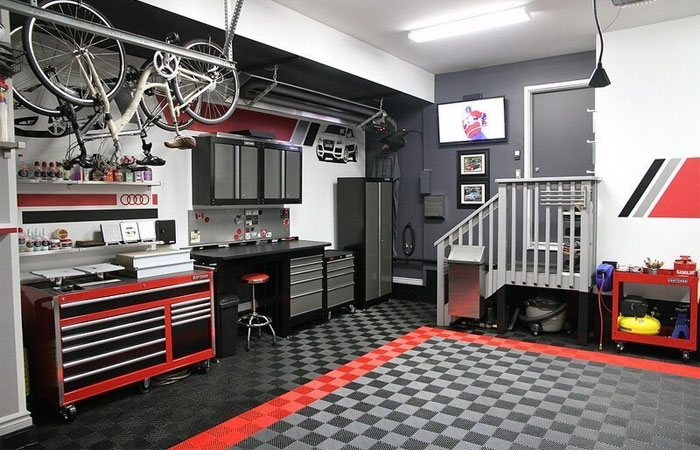
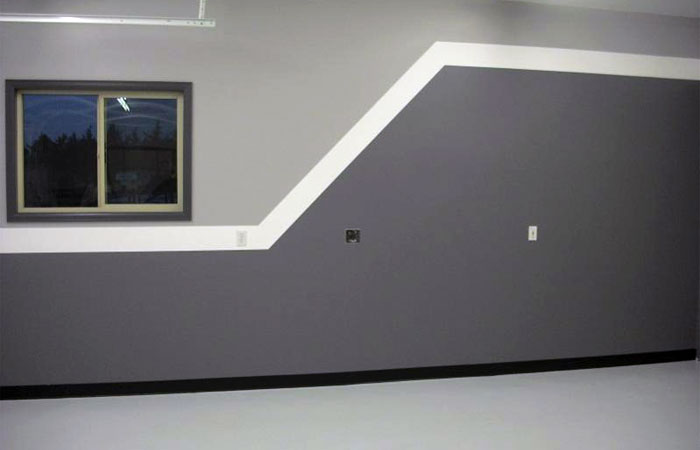
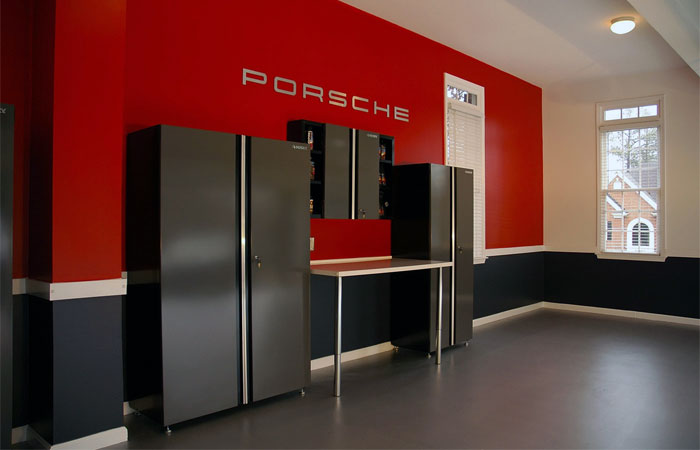
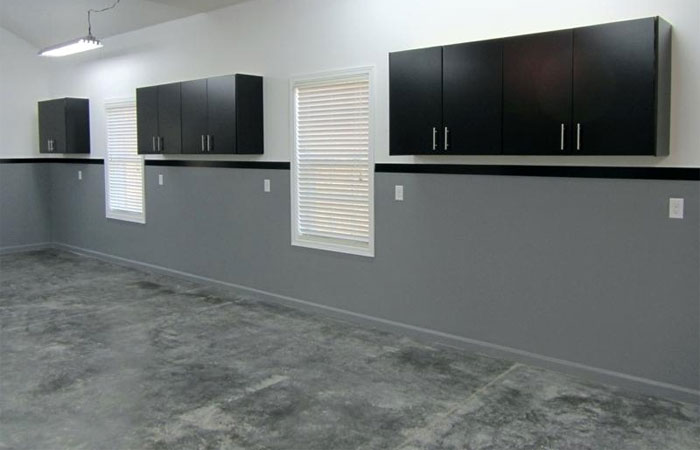
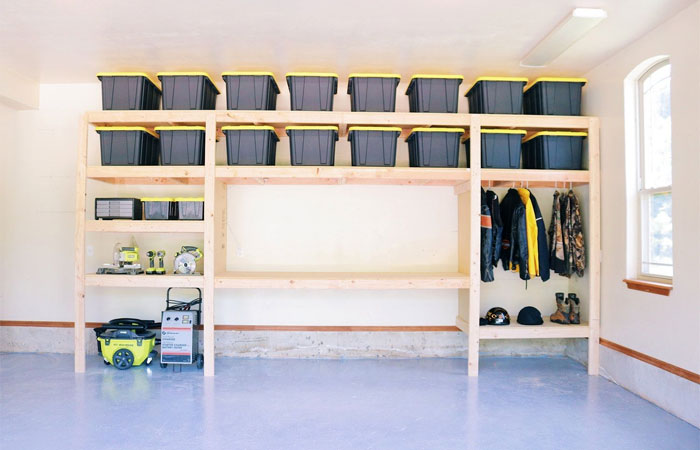
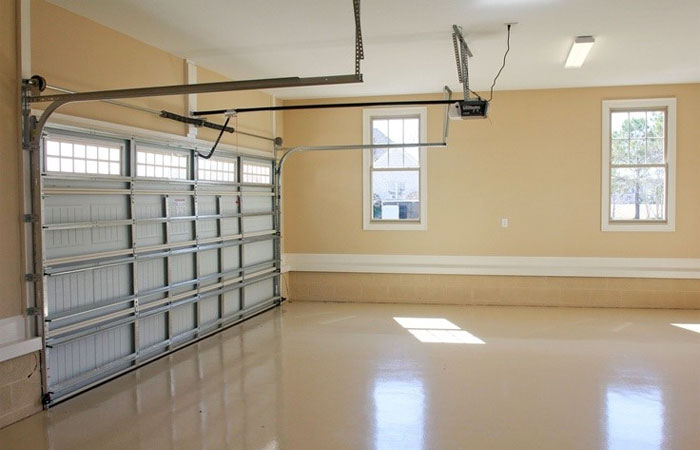
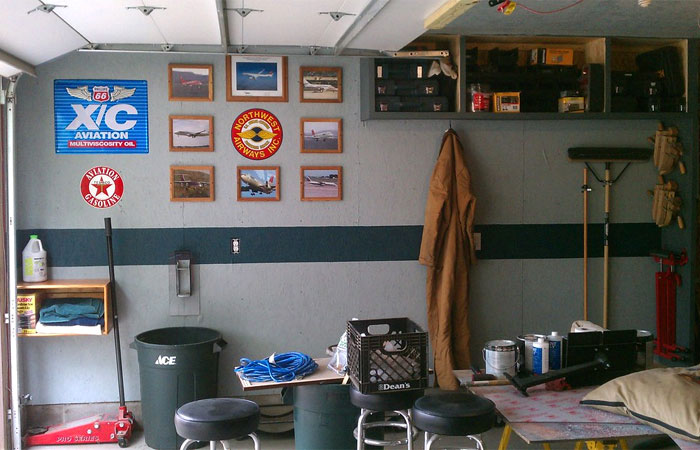
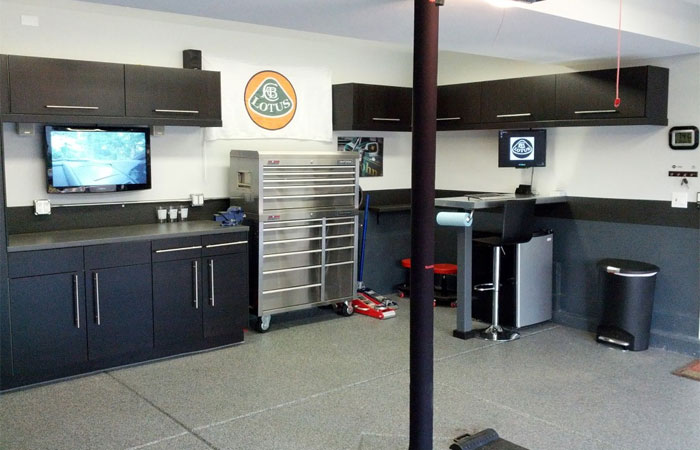
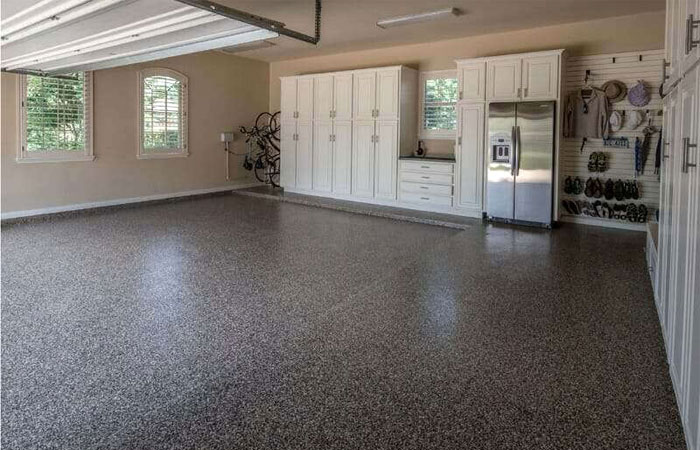
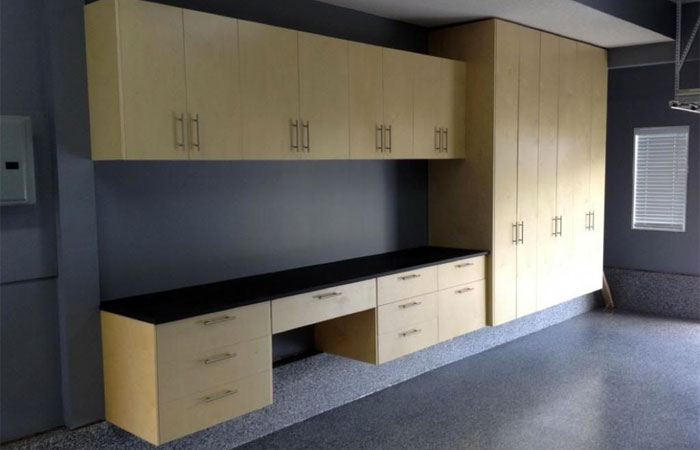
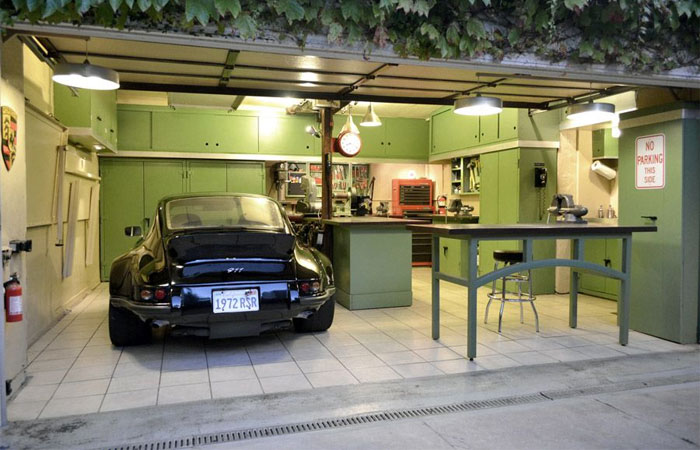
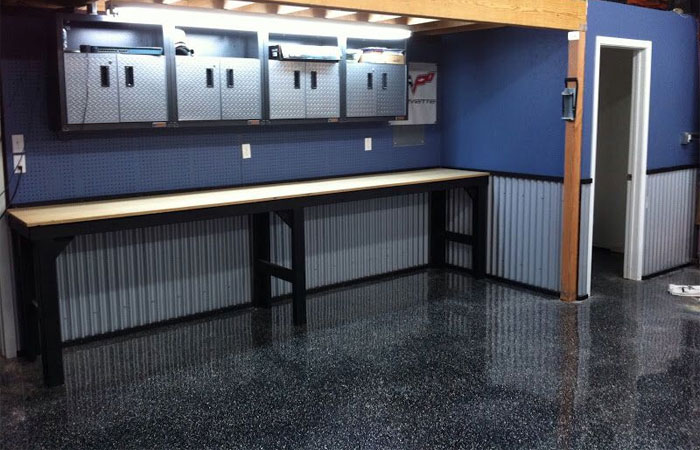
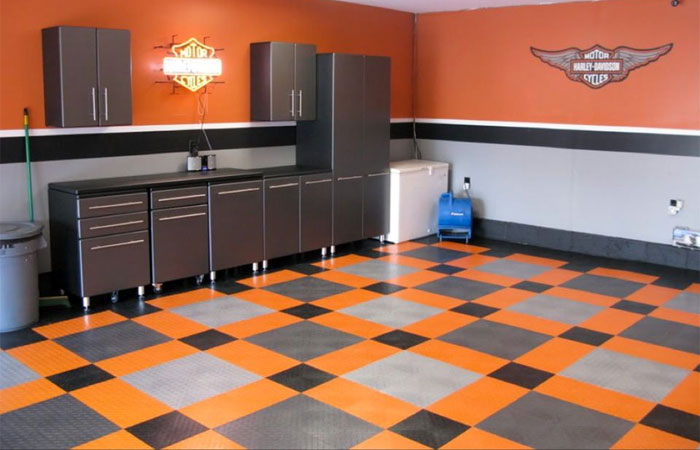
6 Tips for Interior Garage Paint and Design
#1 – Choose the Right Type of Wall Paint
There are many types of paint available on the market. The “best” paint depends on the environment and conditions.
Oil-based paints are strong-smelling, take a long time to dry, and tools and spills need to be cleaned with paint thinner. However, one coat of oil-based paint is usually all that is needed due to the superior coverage and the way the paint bonds to difficult surfaces more easily.
Latex-based paints have a much less noticeable smell, dry quickly, and can be cleaned away with water. They don’t last as long and often require a primer and/or multiple coats for complete coverage, though modern paints sometimes boast better coverage.
Paints come in a variety of finishes, or amount of light reflecting capabilities. Glossier paints are easier to clean but reflect light (and highlight imperfections) a lot. Matte paints are very forgiving of nicks and scratches but can’t easily be cleaned as paint usually comes off with the dirt. Semi-gloss finishes are a common choice for interior garage wall paint as the walls become easy to clean and reflect light well.
It’s important to choose an interior paint rather than exterior, as the latter can contain toxins that are not meant to stay in an enclosed space. These toxins are found in weatherproofing compounds.
When it comes to choosing the best paint for garage walls, interior latex paint in a semi-gloss sheen is what you usually want to go with. It’ll be easy to clean, durable, and not show every little imperfection in the wall surface.
Some paints are labeled as “low-VOC” or “zero-VOC”. VOC are volatile organic compounds, carbon-based substances which emit gases at room temperature. Toxins in paint are unavoidable with current technology so it’s best to keep them confined to their place on the wall rather than allowing them to off-gas into the air of the indoor space.
Choosing “zero-VOC” or “low-VOC” when possible is safer, though “low” is relative with no current standards to define the number of VOC present in the paint.
#2 – Choose a Color Scheme
A color scheme consists of one main color (usually neutral or muted) with a secondary color (often the same color but lighter or darker) and one or two accent colors (which are often brighter or bolder).
According to Home Awakening, the first step in choosing a wall color and accent color(s) for your garage is to consider the purpose of the garage for you. Is it going to be a space where you’ll be doing auto repair, maintenance, or detailing? Will it be used mainly as a woodshop? Will it be man cave where you and your friends will hang out and watch the game? Or will it simply be a space to park your car and store anything that won’t fit in the house?
Darker colors tend to lend more of a closed-in and relaxed feeling while light colors make the room feel larger as they reflect light more easily. Bright colors are invigorating and muted colors are calmer. Lighter colors also show dirt more easily than darker ones.
Colors can be chosen to match or complement any exposed foundation, the exterior of the garage, a certain brand (such as your car or power tools), tool chests or cabinets, or your favorite sports team. Since your vehicles will likely be the most noticeable things in the garage, you’ll want to make sure the walls go with the car. For instance, if you car is purple, you probably don’t want red garage walls.
If you’re planning on upgrading your standard concrete floor with garage tiles or an epoxy coating, you need to take that into account as well. Even applying a good concrete sealer over the floor can dramatically change things if it has a glossy finish.
Sometimes it’s easier to start with your favorite neutral color (ie: white, gray, or beige) and then add one or two accent colors that match something in your garage (ie: vehicle, tools, cabinets). This is a safe way to get started.
Once you’ve chosen the general wall color for your interior garage, get several paint swatches of colors from various manufacturers. Look at them more closely in your actual garage and then decide on a couple to get paint samples for (these cost money so don’t go crazy).
Paint large patches on the garage walls with your sample paint to see how you like them, then buy your favorite color in the amount that you need for the entire garage.
#3 – How to Paint Garage Walls
After you’ve decided on the color for your garage walls and ceiling (the ceiling material doesn’t have to be drywall), write down the garage dimensions to take to your local Home Depot, Lowes, or other home improvement store or paint store so you know how much paint to buy. Some surfaces and paint types may only need one coat of paint but if covering up a darker color, two coats may be needed.
If using the same type of paint (oil- or latex-based) as the current surface, the surface should be cleaned with a mild soap and water or TSP. It should be primed if switching from a darker color to a lighter color.
Unfinished drywall needs to have cracks or imperfections repaired first and then all of it must be primed with drywall primer. Drywall is very porous, so unfinished drywall would soak up all of the paint leaving you with an uneven finish.
Related: How Many Coats of Primer Do You Need?
Wood walls should be cleaned and sanded to ensure an even surface. Brick walls need to be cleaned with a wire brush and TSP cleaner. Any cracks in concrete walls should be filled and then the surface cleaned.
Mixing finishes can be tricky and should be avoided in most cases. If applying a latex-based paint to walls covered in oil-based paint, first sand the walls, clean them well, and prime with bonding primer to encourage the paint to stick.
It’s not a great idea to use oil-based paint on a surface covered in latex-based paint, since the latter is more flexible (more easily expand and contract) and oil-based paints have a hard finish, so the changes can cause cracks in the top layer. But as noted above, you shouldn’t be using oil-based paint for interior walls in the first place.
When you are preparing to paint your garage, remember that ventilation is crucial. It’s best to paint with the garage door open to ensure adequate airflow, for both safety and to lessen dry time.
#4 – Garage Flooring Options
The floor of the garage can be changed using a variety of techniques. There is no “best” way to change your floor since individual materials excel in different situations. Consider your priorities: appearance vs durability vs cost.
No matter which garage flooring option you go with, using a good concrete cleaner is essential if you want good results.
PVC floor tiles are a popular choice, as they are easy to install in endless combinations for a personalized look. They interlock so sticky and annoying adhesive isn’t needed.
See Also: Best Garage Floor Tiles for That Custom Look
If cost is an issue, peel-and-stick tiles use that adhesive to cut costs while still allowing for a custom pattern with easy installation. These only work on smooth and level floors.
Roll-out vinyl is great for cheap and easy installation but isn’t durable. Custom patterns are much more difficult (if not impossible), and rips and tears aren’t easily repaired.
The concrete floor can also be coated. Coating it with epoxy makes for a durable and easy to clean surface. It is relatively easy to customize by choosing the color (and even texture), but can be tricky to install. It’s recommended that epoxy coating be installed by professionals for best and long-lasting results.
A simple concrete sealer will make the floor more durable by not allowing engine oil or other fluids to penetrate the surface making oil stain removal much easier. Clean and unstained concrete can be bonded to concrete stain for a neat long-lasting effect.
If you plan on working with metal or wood or working on your car in the garage, it’s a good idea to protect the concrete floor from damage and spills with a good sealant or epoxy.
#5 – Storage as Decor
Storage equipment can often tie into the general color scheme of the garage. Wall mounted cabinets, wooden storage units, and workbenches and countertops can often be painted.
If you are adding any storage, consider what it is meant to contain so that those things (i.e. totes, tires, tools) fit well. Cabinets should be installed a bit off the floor to protect them and their contents from rodents, oil, water, and other liquids which may spill on the floor.
Some people like to use a pegboard to organize tools. These can be easily painted in a neutral color or an accent color for more visual interest. Stainless steel pegboards are another good option to complete the look. Chalkboard paint is also becoming more popular, as a prepared chalkboard surface makes for effortless labeling and organizing.
#6 – What Else to Update?
If you’ve been bitten by the painting bug and already finished the walls, there are other surfaces in the garage that can be updated to further change the look of your garage.
Simply changing out the hardware on the cabinets and doors can make a big difference in the appearance. Adding or removing doors on wood cabinets can make a big difference.
If your garage has baseboards or paneling, it too can be painted. Baseboards are usually white, but feel free to try out a different color that works well with your wall color. If making a bold choice, paint a small section first to make sure you still like it before you paint the boards on the entire room.
The ceiling is usually white but is often painted the same color as the walls. White ceilings make the room feel taller and lighter while using the same color in the entire room looks cohesive.
Related: 7 Best Garage Lighting Ideas
The door leading to the home is another good place for a pop of color if that’s what you are looking for.
The outside garage door should be a color that complements the home and doesn’t distract from the front door of your home (which is the focal point). It’s also a good idea to use a light color to reflect heat away from the interior of the garage.
When the walls are completely dry, feel free to further personalize the garage by adding in murals, posters, wall art, signs, or a clock. The possibilities for interior garage design are endless.

